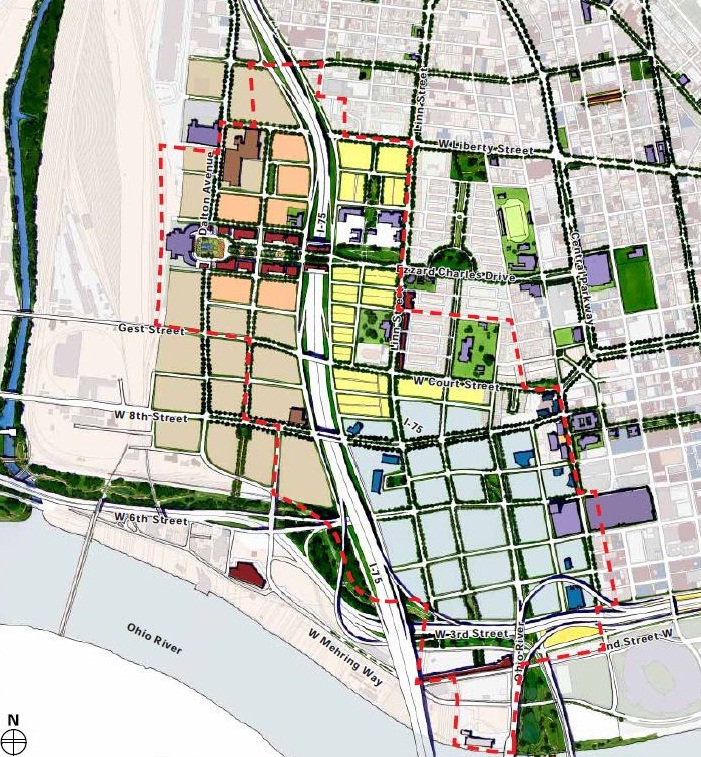So I have been getting nervous lately because Kentucky seems to be getting their act together on the Brent Spence. Maybe I am generalizing too much, there are exceptions, but on the whole I would describe Kentucky as anti-urban.
I have a plan that is very different than that put out by OKI, the agency that determines most transportation funding in the region. My plan would increase transit ridership and urbanization. (see next post) OKI's plan is not even trying.
Lets look at it.
OKI's plan is for the number of people living near transit to decline by 9.2% from 713k to 647k.
Source: OKI 2012 Transportation Plan, p. 41
OKI plans to achieve this goal by emptying out the City of Cincinnati.
Source: OKI 2012 Transportation Plan, p.6
How does this relate to the Brent Spence? The organization that leads planning for the region and determines what projects are eligible for federal money is not planning for an urban future. They are focused on getting more people from the suburbs to the suburbs. The additional* bridge next to the Brent Spence is often billed as a freight project, however the existing bridge - like most highways - is under utilized outside of commuting hours. The additional bridge is for commuters.
If the region were to focus on increasing transit ridership and focus development on urban areas Cincinnati could make the
halt to VMT growth permanent. While the project site only list documents back to 2005, initial plans for the BSB addition were done before that. The chart below shows how any forecast done before 2007 is going to over project highway demand.
It is tough to be an urbanist in Cincinnati. You have to find a way to get OKI board members from Kentucky, Indiana and Butler County to agree to stop development in their areas to focus resources on the urban core. Not even the City of Cincinnati can agree with its self to to this. However, without this focus, the wrong infrastructure will be built.
The additional BSB
could be built in a way that
frees up space in downtown Cincinnati. This plan was rejected because it displaces too many businesses and utility lines. I would hope that the leaders of the most expensive project in the regions history would have the courage to move a few power lines. The businesses that would be displaced are car dealerships and single story warehouses. These are not the kind of business that belong walking distance to the urban center. The region should demand that these business be relocated for under utilizing our precious urban space. There is no excuse for keeping the current rats nest of ramps adjacent to the central business district.
Image: Urban Cincy / Revive I-75 study
Adding an additional bridge next to the BSB will be the noose that strangles downtown Cincinnati for the next 50 years. This is a now or never moment for downtown Cincinnati.
Prior to the 1950's all transportation was funded based on property value impacts. Land developers would built transit because they wanted to increase property values. Local governments improved roads to improve local property values. When transportation funding became linked to the gas tax rather than property values, the goals shifted. Rather than making great places, transportation funding went to "reducing congestion". This means moving cars faster - a self perpetuating cycle that increases gas taxes.
A breakdown in gas tax ( not increasing with inflation) has broken this cycle for and driven transportation funding back to local (or at least state) government. The people that are planning the additional bridge are once again linking the funding to the number of vehicles that drive. This has resulted in a configuration that maximizes vehicle movement while ignoring potential property values. The opportunity cost of not moving I-75 is nowhere in the equation.
Lets review:
- OKI is not urban oriented
- The Highway Trust Fund/ fuel tax is not urban oriented
- The most expensive project in the Cincinnati urban core is about to happen
- It is not urban oriented
Maybe this - drive less, back to the city - thing is a fluke that will fix itself once it is easy to drive again. That is what we want right?
See the next post for my alternative to the additional bridge for I-75.
*I encourage everyone to refer the the Brent Spence Bridge project as an additional bridge as the current bridge that is soooo dangerous and at risk of falling down is not going anywhere under any plan. The engineers agree that it is in good enough condition to keep.









